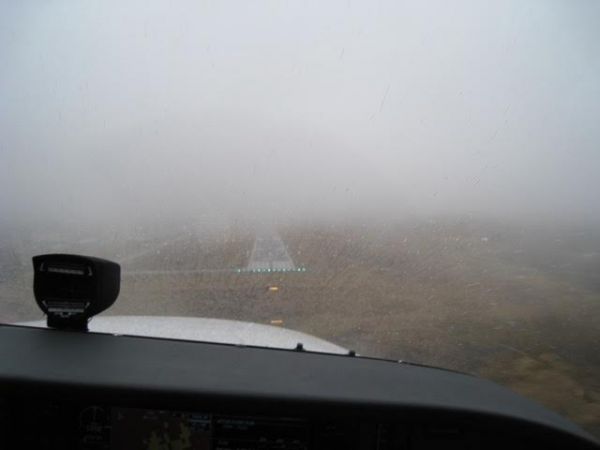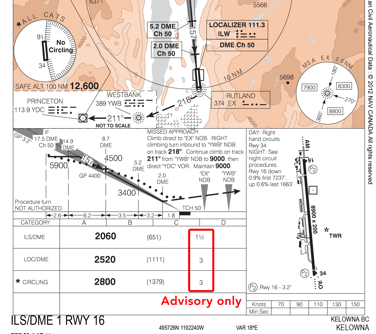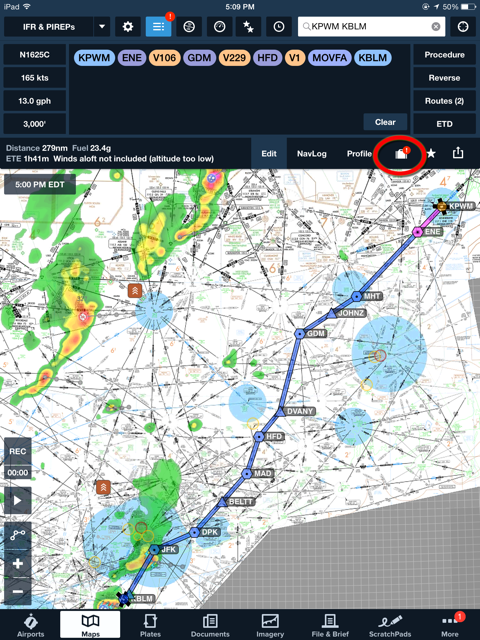Does Your Approach Use the Wrong Minimums?
It’s a dark and stormy night. You’re instrument current and proficient. Your bird is well equipped. But you’re concerned because the reported ceilings have been going up and down on both sides of the published minimums.
To which I say, “Who cares?”
Seeing Is What Matters
Put yourself on the approach and descending. You will either break out to see something, or you won’t. It’s binary; one or the other. If you see nothing before the prescribed moment arrives, you commence the missed approach. Simple. If you see something, now you must judge.

And there’s the key. It’s visibility that controls whether you can land or not. While on paper it’s binary, it’s not so simple in real life. You have to make a rapid judgment call as to whether you’re getting enough visual information at a glance to justify calling the flight visibility half a mile, or three-quarters of a mile, or two miles, or whatever.
That’s why I want to know what I expect to see when that moment arrives. Am I expecting the approach lights with a green threshold and not much more? Am I expecting half a visible runway 20 degrees left of my nose?
I think it’s our training where we fly down to an altitude and then go missed that gets us so focused on altitude. In real IFR, what we need to be focused on is distance: When you get down to X, how far should you be able to see out to Y?
This kind of thinking also allows for a certain consistency. Fly the approach to DA/MDA, period. Somewhere along the way, visibility should get high enough that you can land when you get there. You note that happening—and continue on the approach until it’s operationally beneficial to think “landing.” When vis is really low, that’s probably about 50 feet AGL.
When I read NTSB reports, the instrument approach crashes seem to fall into two categories: grossly botched at altitudes well above the +500 or even +1000 people set as personal minimums, or unknown flying into the trees or approach lights at the very end. Ceilings weren’t the issue on the first ones, but visibility is a likely culprit on the latter. I think we do ourselves a disservice assuming these are “duck unders” where pilot descended too low. I’ll wager a six of good beer the majority were continuing past DA or MDA into questionable visibility that wasn’t IMC, but wasn’t sufficient to safely find pavement.
That’s why I’ll happily shoot an approach that’s calling a bit below minimums for DA or MDA so long as the visibility is good beneath. It’s also why I won’t bother with an approach with visibilities too low for likely completion, even if the ceilings are several hundred feet above the published minimum.
Commercial operations usually work the same way; visibility rules.
Sure, there’s value in noting the ceiling versus MDA/DA to see if there’s even a chance, but if it’s close, go for it. While I don’t particularly buy in to personal minimums at all, if I was setting a personal minimum for approaches, it would be by visibility, not ceiling.
Maybe you don’t really worry about visibility at the end of an approach? If you can see some runway, you just land? Your call, but that really is in violation. And while I will admit to knowing it’s possible to find the runway and land in RVR 800, I only do so knowing the statue of limitations is up on that knowledge. And I swear the flight visibility was higher. Really.
But now I’m (luckily) older and (thankfully) wiser. Today, visibility is what matters.
Watch This Video:
Lower Your Personal Minimums
Canadians See It Differently

Fly in that country north of the border and this discussion changes. In Canada, prior to the FAF, visibility is controlling for both commercial operators and GA. The details are complicated, but roughly, commercial operators need 50 to 75 percent of the published visibility minimums to commence the approach. GA operators need RVR 1200. (Again, I’m being broad-brush here.)
Once passed the FAF, however, the published visibilities on Canadian approach plates, “are advisory only. … They are not limiting and are intended to be used by pilots only to judge the probability of a successful landing.” In Canada, if you reach DA/MDA, can see the runway environment at all, and decide there’s enough visual information to land successfully, go for it.
Man, even their regulations are friendly.
ForeFlight Question of the Month:
True or false: If you have your destination area and all charts selected in your download settings, you don’t have to bother with the “pack” feature for a flight plan., because you have all the information you need to fly an approach saved on your iPad already.


